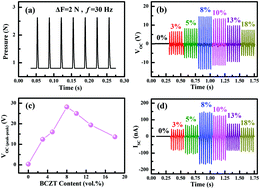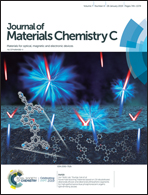The alignment of BCZT particles in PDMS boosts the sensitivity and cycling reliability of a flexible piezoelectric touch sensor†
Abstract
With the rapid development of wearable devices, a highly sensitive flexible piezoelectric sensor shows tremendous potential for future demands. Here, we report a novel lead-free flexible piezoelectric sensor fabricated by a composite with chain-distributed (Ba0.85Ca0.15)(Ti0.90Zr0.10)O3 (BCZT) particles in a polydimethylsiloxane (PDMS) matrix. The BCZT particles were prepared by a conventional solid oxide process and then dispersed in PDMS oriented by the application of a dielectrophoretic alignment field. The fabricated aligned flexible composite with 8 vol% BCZT addition had a high open circuit voltage of 28.8 V (peak-to-peak), which was nearly twice as high as that of the randomly dispersed composite. This new mechanically reinforced flexible piezoelectric composite was demonstrated to resolve the problems of the weak stress transfer to piezoelectric elements and the poor dispersion of fillers in the polymer matrix. The 8 vol% BCZT/PDMS composite was incorporated into a flexible piezoelectric touch sensor, which possesses excellent sensitivity in a wide pressure range and an extraordinary cycling stability. These results indicate that the fabricated flexible piezoelectric sensor has great potential in the wireless sensor network and wearable electronic fields.



 Please wait while we load your content...
Please wait while we load your content...